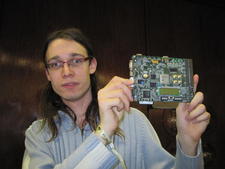26C3: Milkymist Visual Synthesizer Soon with Ethernet and USB
Initiator and main developer of the Milkymist project, Sébastien Bourdeauducq, showed a prototype of his visual synthesizer at the latest Chaos Congress and builds his own board for it.
Bourdeauducq describes his one-and-a-half-year-old system on a programmable chip (SoPC) as "eye candy on a chip." The board shown in a schematic diagram, with a soc-lm32 CPU, FPGA and floating-point coprocessor, visualizes audio input and renders its moving images over VGA. The name Milkymist comes from Bourdeauducq's association with MilkDrop, a visualization plugin for the Winamp audio player.
In his talk at the Berlin conference he covered how he solved the speed and RAM capacity problem with a minimum of expense. For a rate of 30 pictures per second at 1024 x 768 pixels, the texture mapping unit (TMU) needed to process 24 million pixels. Because memory, according the SoaC designer recently graduated in Sweden, depends on intelligent controller programming, he lets it gather into four memory chunks (a "burst") before releasing it, instead of one chunk at a time. His studies revealed that field-programmable gate arrays (FPGAs) are hugely underrated -- they're easy to obtain and dependable, but underused.
 With his Milkymist platform Bourdeauducq wants to provide visual jockeys (VJs) with "MilkDrop-esque" effects as a compact SoC.
With his Milkymist platform Bourdeauducq wants to provide visual jockeys (VJs) with "MilkDrop-esque" effects as a compact SoC.
The first prototype of his SoC was based on the $500 Xilinx ML401 board, which ran Linux kernel 2.6.23 and simulators such as Verilog with GPL Cver. Mid-2009 he presented his visualizer at the Hackerspace Festival in Paris. Since two months it now he is building his own board, which Bourdeauducq gave Linux Magazine Online a glimpse of.
The new board, which has a smaller footprint, processes audio and video input and have an Ethernet and USB interface. The Frenchman wants to swap the previous CF memory card with an SD card. According to his November writeup, it should eventually run on µClinux. The previous software is available in source and binary versions as well as a Debian package.
 Bourdeauducq with his prototype of the visual synthesizer. Instead of the Xilinx ML401 board that normally runs soc-lm32, he designed his own, which also has USB and Ethernet ports.
Bourdeauducq with his prototype of the visual synthesizer. Instead of the Xilinx ML401 board that normally runs soc-lm32, he designed his own, which also has USB and Ethernet ports.
Motivation for the project was to produce a completely open system on the hardware side. The BeagleBoard was too closed for Bourdeauducq: it's based on the proprietary OMAP chip and some of the drivers are also proprietary. "Texas Instruments," he complains, "does its own boards and otherwise marketing, for inexpensively produced software."
Subscribe to our Linux Newsletters
Find Linux and Open Source Jobs
Subscribe to our ADMIN Newsletters
Support Our Work
Linux Magazine content is made possible with support from readers like you. Please consider contributing when you’ve found an article to be beneficial.

News
-
Parrot OS Switches to KDE Plasma Desktop
Yet another distro is making the move to the KDE Plasma desktop.
-
TUXEDO Announces Gemini 17
TUXEDO Computers has released the fourth generation of its Gemini laptop with plenty of updates.
-
Two New Distros Adopt Enlightenment
MX Moksha and AV Linux 25 join ranks with Bodhi Linux and embrace the Enlightenment desktop.
-
Solus Linux 4.8 Removes Python 2
Solus Linux 4.8 has been released with the latest Linux kernel, updated desktops, and a key removal.
-
Zorin OS 18 Hits over a Million Downloads
If you doubt Linux isn't gaining popularity, you only have to look at Zorin OS's download numbers.
-
TUXEDO Computers Scraps Snapdragon X1E-Based Laptop
Due to issues with a Snapdragon CPU, TUXEDO Computers has cancelled its plans to release a laptop based on this elite hardware.
-
Debian Unleashes Debian Libre Live
Debian Libre Live keeps your machine free of proprietary software.
-
Valve Announces Pending Release of Steam Machine
Shout it to the heavens: Steam Machine, powered by Linux, is set to arrive in 2026.
-
Happy Birthday, ADMIN Magazine!
ADMIN is celebrating its 15th anniversary with issue #90.
-
Another Linux Malware Discovered
Russian hackers use Hyper-V to hide malware within Linux virtual machines.
